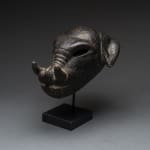Zoomorphic Mask, 20th Century CE
height 22.9 cm
height 9 in
height 9 in
LSO.237
Further images
Most tribes in Africa, whether or not agriculturally-based, maintain a strong link with their natural environment. To this end, they tend to endow wild elements – especially wild beasts –...
Most tribes in Africa, whether or not agriculturally-based, maintain a strong link with their natural environment. To this end, they tend to endow wild elements – especially wild beasts – with spiritual significance, and thus incorporate them into their pantheon of spirits, or perhaps gods. As a result, many such oeuvres are non-diagnostic, as in the current case.
The carving style and manner of manufacture suggest that it may have been made by the Yoruba, but such a mask is not a conventional form in their repertoire. The pygmies are known to make zoomorphic masks, and have a fascination with elephantine forms. Likewise, the Guro make a range of animal masks, but their manner of manufacture is different from the current example. However, the details of cultural authorship are not particularly important, as in that sense this mask is representative of many tribes’ relationship with their cultural and natural environment. It depicts an animal with various characteristics, including a pig/warthog, an elephant and some form of carnivore, to judge from the teeth.
The mask has been well used and has a glossy patina. The forehead is domed, giving way to an elephant-like eminence above and between the eyes, running down to a small trunk-like protuberance. Small tusks, or perhaps tushes, are also present, along with the flop ears of a pig. However, if scale has been ignored, all these traits might be said to be indicative of an elephant rather than the other candidates. It is likely to have been made for a masquerade performance, perhaps as a spiritual representative of the “bush”, like the owl masks of the Mossi. It’s fairly fearsome appearance and colouring could be interpreted as a symbol of power, even negative power, like the spirits of the Baule people who must be kept at bay through magic and ritual. The edges of the mask are drilled around the perimeter, so it is probable that it was worn with a textile or fibre costume designed to conceal the identity of the wearer and thus boost through anonymity the impact of the character’s message. If meant to scare, it might well have been used in some initiation ceremony, like the circumcision masks of the Lulua, which are designed to frighten the teenagers who are unwillingly taking part. Alternatively, it might be a character in a tribal myth, or an evil spirit defeated by a tribal hero. Whatever the reason, this is a powerfully carved and eloquent piece.
The carving style and manner of manufacture suggest that it may have been made by the Yoruba, but such a mask is not a conventional form in their repertoire. The pygmies are known to make zoomorphic masks, and have a fascination with elephantine forms. Likewise, the Guro make a range of animal masks, but their manner of manufacture is different from the current example. However, the details of cultural authorship are not particularly important, as in that sense this mask is representative of many tribes’ relationship with their cultural and natural environment. It depicts an animal with various characteristics, including a pig/warthog, an elephant and some form of carnivore, to judge from the teeth.
The mask has been well used and has a glossy patina. The forehead is domed, giving way to an elephant-like eminence above and between the eyes, running down to a small trunk-like protuberance. Small tusks, or perhaps tushes, are also present, along with the flop ears of a pig. However, if scale has been ignored, all these traits might be said to be indicative of an elephant rather than the other candidates. It is likely to have been made for a masquerade performance, perhaps as a spiritual representative of the “bush”, like the owl masks of the Mossi. It’s fairly fearsome appearance and colouring could be interpreted as a symbol of power, even negative power, like the spirits of the Baule people who must be kept at bay through magic and ritual. The edges of the mask are drilled around the perimeter, so it is probable that it was worn with a textile or fibre costume designed to conceal the identity of the wearer and thus boost through anonymity the impact of the character’s message. If meant to scare, it might well have been used in some initiation ceremony, like the circumcision masks of the Lulua, which are designed to frighten the teenagers who are unwillingly taking part. Alternatively, it might be a character in a tribal myth, or an evil spirit defeated by a tribal hero. Whatever the reason, this is a powerfully carved and eloquent piece.





